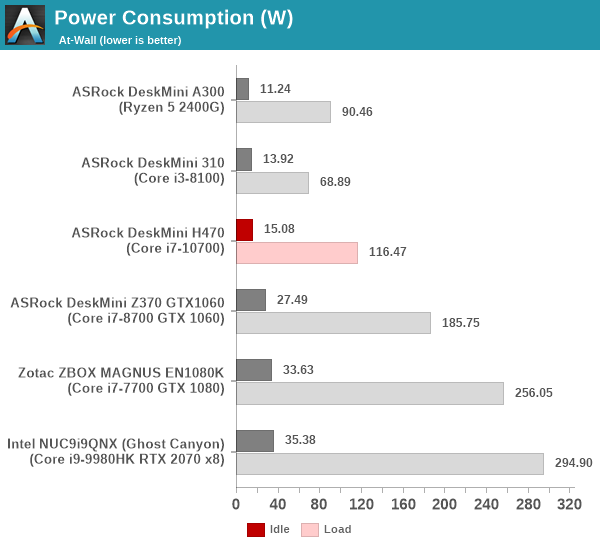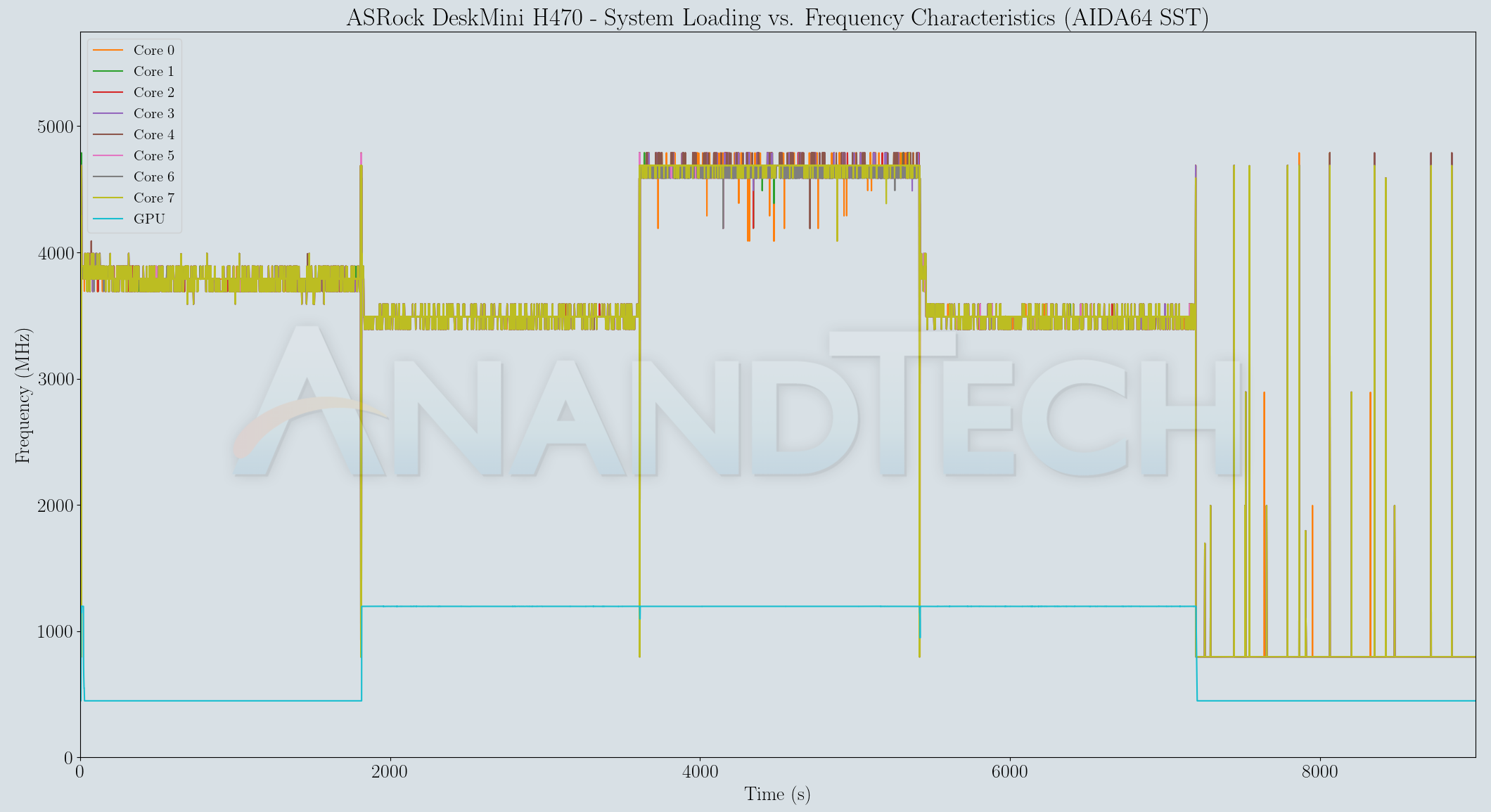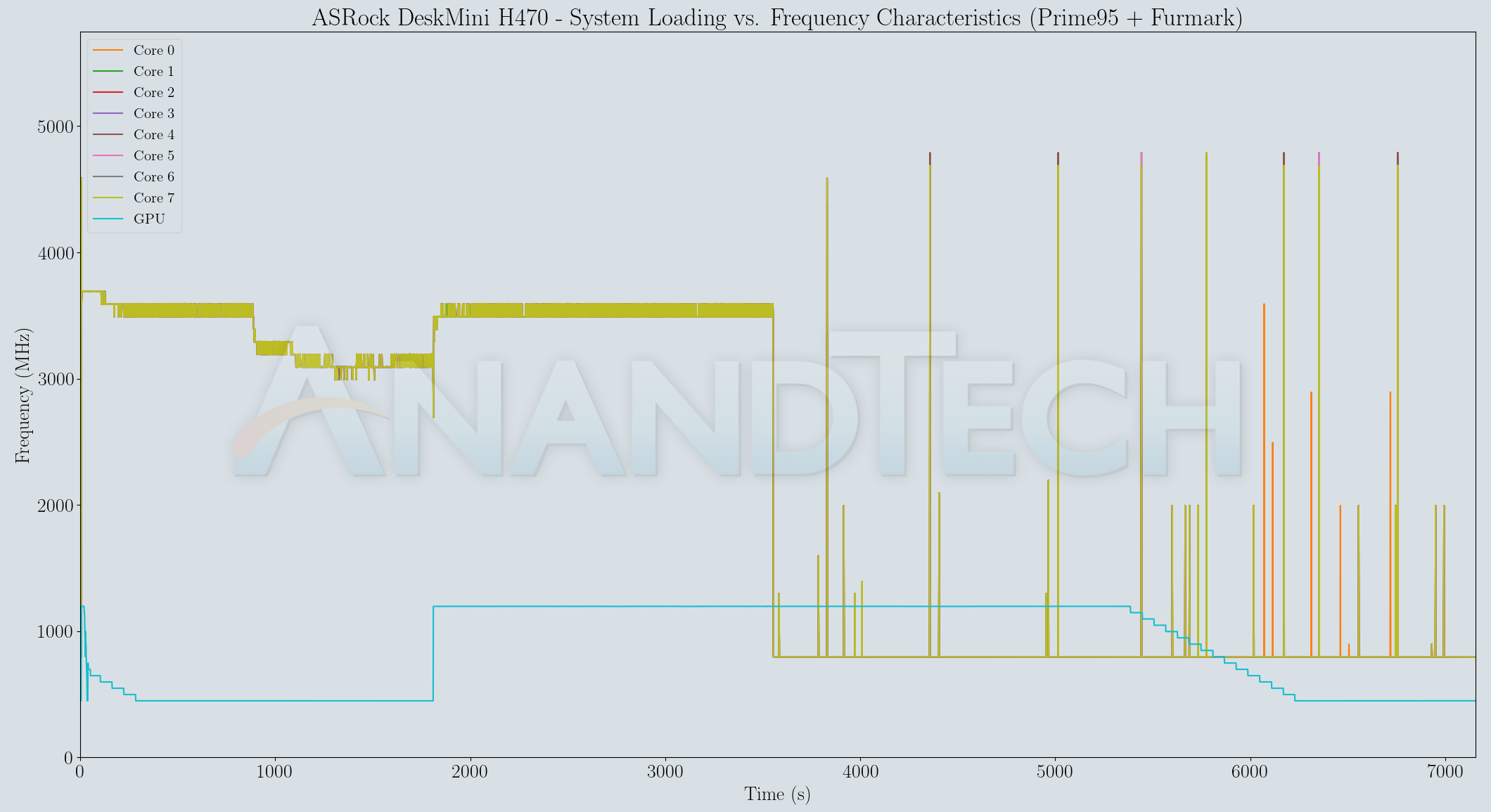ASRock DeskMini H470 Review: A No-Frills LGA 1200 mini-PC Platform
by Ganesh T S on December 29, 2020 8:00 AM ESTPower Consumption and Thermal Performance
The power consumption at the wall was measured with a 4K display being driven through the DisplayPort port in non-HDR mode. In the graphs below, we compare the idle and load power of the ASRock DeskMini H470 with other low power PCs evaluated before. For load power consumption, we ran the AIDA64 System Stability Test with various stress components, followed by our custom stress test (Prime95 and Furmark) and noted the maximum power consumption at the wall.

The idle power consumption can be classified into two sets - systems equipped with discrete GPUs idle at 25W+, while ones without idle aroud 10W+ lesser. Compared to other dGPU-less systems, the DeskMini H470 leads the idle numbers at 15W. On the load side too, we see it at the top of the charts in its class thanks to Intel's efforts to get as much performance as possible with suitable PL1 and PL2 numbers for its Comet Lake-S processors as the system design might allow.
Our thermal stress routine starts with the system at idle, followed by four stages of different system loading profiles using the AIDA64 System Stability Test (each of 30 minutes duration). In the first stage, we stress the CPU, caches and RAM. In the second stage, we add the GPU to the above list. In the third stage, we stress the GPU standalone. In the final stage, we stress all the system components (including the disks). Beyond this, we leave the unit idle in order to determine how quickly the various temperatures in the system can come back to normal idling range. The various clocks, temperatures and power consumption numbers for the system during the above routine are presented in the graphs below.
| ASRock DeskMini H470 System Loading with the AIDA64 System Stability Test | |||

The system has no trouble keeping the package power at 65W - this is what the processor is rated for, and the DeskMini H470 configuration allows exactly that. Core clocks stay well above the rated 2.9 GHz for the most part and the GPU clock is steady during the course of the stress segments where the GPU is active. The Silverstone SST-AR11 heat-sink does wonders - the package temperature never crosses 65C! However, the absence of airflow to other components is an issue - the voltage regulators touch 100C and one of the SSD temperature sensors goes as high as 80C when the SSD is stressed.
| ASRock DeskMini H470 System Loading with Prime95 and Furmark | |||

In the custom stress test involving Prime95 and Furmark, the package power consumption stays at 65W for scenarios involving the CPU. However, when the GPU alone is stressed, the number falls down to a sub-30W value. This is not due to any thermal limitations, but just the nature of the iGPU in the Core i7-10700. The GPU clock stays at the rated 1200 MHz during the full GPU-loading segment. Core clocks are also above 2.9 GHz in the first two segments. The reason for the variation / push down of the core clocks around halfway through the Prime95-only scenario is because of the temperature of the voltage regulation circuit. It shoots up as high as 105C even when the cores themselves are at 60C only.
The DeskMini H470 configuration tested above has no problems with thermal limits on the processors thanks to the excellent performance of the Silverstone SST-AR11 heat-sink. However, the case design has limited airflow as there is no other fan to cool down the SSD and/or voltage regulating circuitry. Any performance limitations are due to the thermals associated with the VRMs. While the installed CPU can do work corresponding to its rated power consumption numbers / TDP, there may be limitations on trying to extract the last bit of performance from the processor - an aspect that ASRock tries hard to deliver with features such as the 'base frequency boost' in the 'OC Tweaker' BIOS section.










26 Comments
View All Comments
Tomatotech - Tuesday, December 29, 2020 - link
That’s possibly one of the best possible arrangements for the m.2 slot then as the metal tray will be an excellent heat sink. You could even add a bit of thermally conductive foam (make sure it’s not the electrically conductive type) to help with heat transfer to the tray.ganeshts - Tuesday, December 29, 2020 - link
The Ultra M.2 slot is on the top side of the board. That is the one used with Comet Lake CPUs. The slot you are referring to is the Hyper M.2 (PCIe 4.0 x4) slot which is usable only when the Rocket Lake CPUs come around.twotwotwo - Tuesday, December 29, 2020 - link
Its AMD relative the A300 was my main machine for a while, and had it been easier to get Zen 2 desktop APUs I might still be using it. Quiet (given a decent fan), cheap, tiny (obvs), reasonably expandable, gets the job done--about all I can ask for from a work desktop.Death666Angel - Tuesday, December 29, 2020 - link
The 4000 Series Pro APUs are pretty well available in Germany, from reputable online retailers. I can get the R5 Pro 4650G for 20% more than the equivalent R5 3600 (200€ vs 240€ roughly). That would be my sweet spot, personally. For 8 cores it's also roughly 20% (280€ vs 340€) but for that price difference, you could get a nice used GPU already that will maybe game better. I personally could never justify a GPU-less build, although I am eternally curious about them and plot one out once every couple of months.... and then I look at benchmarks of dGPU vs iGPU and stop. :DTomatotech - Tuesday, December 29, 2020 - link
I didn’t see it in the article so here are the specs:155 x 155 x 80 mm (1.92L)
Not bad, though for most low to mid-level use cases it’d be far cheaper to buy a used Lenovo or Dell USFF PC - these have even less volume at around 1.1L but are slightly larger and flatter (around 180x180x35mm)
For SFF with GPU I still prefer something like the K39 mITX chassis on the low end which comes in at 3L but allows you to use most full-sized GPUs (but for now possibly not the nVidia 3000 series).
Samus - Tuesday, December 29, 2020 - link
I've been rocking the FT03-Mini and while it is an absolute nightmare to work inside of (and I question my sanity for why I put myself through owning it) it is still a very effective ITX chassis for the size, capable of 10.5" videocards, multiple hard drives (plus two m2 drives you can mount to most current motherboards) while using a single 140mm fan to cool everything. Realistically the highest TDP CPU you want to use is around 88-watts as anything more you will stress any closed loop cooler with a 25mm radiator (the max the case can accept) and need to go to a heatsink of some sort with another dedicated fan.Obrut - Tuesday, December 29, 2020 - link
It will be interesting to see a comparison with ASRock Jupiter H470, which has a much different form factor and cooling solution.M O B - Tuesday, December 29, 2020 - link
I have a Deskmini 310w--is the UHD 630 on 10th gen CPUs any faster than the UHD 630 on older CPUs?If not, then it seems like this iteration basically adds some USB 3.0 ports versus my current build.
ganeshts - Wednesday, December 30, 2020 - link
I think the additional angle here is that of a low-cost platform that can take advantage of the RKL-S CPUs coming in 2021. Personally, I also think it is not a great choice to upgrade for those who already have the 310. It is meant more for folks getting their first mSTX machine.Samus - Tuesday, December 29, 2020 - link
I had the SST-AR11 cooler in my Silverstone FT03-Mini and was pretty disappointed (partially due to the chassis inherently poor ventilation) and equally disappointed by closed-loop coolers due to the 25mm thickness limitation of radiators. After spending seemingly hundreds of dollars and way too much time hunting for a thermal solution, some forum posts directed me to try the NT06-Pro, which would theoretically fit this mSTX chassis as long as there is no interference with the power supply.It performs incredible well as you position the fan under the fins and blow the heat away from the motherboard instead of onto it, giving it somewhat of the beneficial effect of a tower-style cooler.